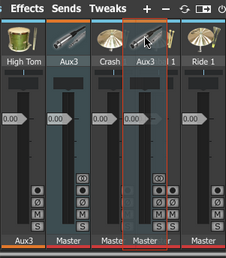Mixer Toolbar
The toolbar at the top of the mixer channels provides several useful functions for managing your mixes.

Export
This button toggles visibility of the Export panel, containing settings relating to exporting audio from BFD3.
View menu
The View menu features several settings to customize the current view of the mixer.
|
Simple When this setting is enabled, certain advanced controls are omitted from being displayed on BFD3's mixer channels: •Input trim controls (Input, Bleed, Sidechain) •Effect/Send slot indicators Animate Hits When this setting is enabled, Drum channels are animated to indicate that an incoming trigger for one of its articulations has been received. |
Meter when muted
If enabled, a channel will show grey metering but have no audio output. If disabled, the channel will show no metering when muted (old behavior).
•Downsteam mixer channels of muted mixer channels will not show a signal. Source channels have to pass a signal to a downstream channel for it to meter when muted.
•A channel receiving active inputs directly from the synth can meter when muted, as muting applies at the final stage of the mixer channel. AUX busses which sum other channels may not get any signal in the first place if all their upstream channels are muted.
•Eg. Load a kit and choose a groove with just a kick drum. Solo a kick direct mic: the snare mixdown buss shows nothing, but if you show the snare’s direct mics they have grey muted metering. Now solo a snare direct mic: there is now a signal passing to the snare mixdown bus. If this is muted, grey muted metering appears again.
Export on Right Enabling the Export on Right setting results in the Export panel appearing on the right side of the mixer when opened, rather than the left. Visibility toggle settings The relevant settings toggle the visibility of Aux Channels, Direct channels, Ambient channels, SideChain and Metronome channels in the mixer. Signal The Signal setting toggles the overlaid signal routing indicators which visually indicate output, send and sidechain routings for the channel underneath the cursor. Add channel Clicking the Add channel button displays a menu of the types of channels that can be added: Aux channels and kit-piece channels/slots. There are also 2 additional functions for automatic routing to newly created Aux channel(s). Add Aux channel (Buss Selected) If one or more mixer channels are currently selected, using this function creates a new Aux channel and sets their Output selectors to route the channels' audio to the new aux channel. Add Aux channel (Send Selected) If one or more mixer channels are currently selected, using this function creates a new Aux channel, creating Send routings to it from each of the selected channels. In this example, the Floor Tom, Mid Tom and High Tom channels are selected before using the Add Aux Channel (Buss Selected) function. The new Aux channel is added to the right of the selected channels. The Output selector of all 3 channels is set to the new Aux channel. Remove channel The Remove channel button removes the currently selected channel(s) from the mixer. Reset Mixer The Reset Mixer button resets the current mixer to the default settings for the currently loaded set of Drums. Clicking the Reset mixer button resets all channel settings to their defaults, as well as removing any FX and Sends settings entirely. You are prompted for confirmation before this is performed. If there are any unused channels in the current mixer, you are also prompted to remove them. Unused channels are typically Drum channels that are empty or do not have any signals routed to them from other Drums. Expand/Collapse all As described earlier in this chapter, this button expands or collapses the sub-mic channels within Kick, Snare and Ambient Mix channels. Mixer Power The Mixer Power button is a global power button for all effects currently loaded into the mixer. It operates in addition to the Power buttons on each effect slot. Therefore, after turning the Mixer Power off and on again, any Power settings that existed previously still apply. Working with the Mixer Selecting channels Click anywhere on a channel in order to select it. The selected channel is highlighted. The last selected Drum channel is shown in the Drum Editor. You can select multiple channels in order to manipulate their controls simultaneously. All selected channels are highlighted. Click any selected channel to select it as the current channel - this can be useful with Drum channels in order to show their settings in the Drum Editor. To select multiple channels: • CTRL-click on a channel (Windows) Adds the channel to the current selection. • SHIFT-click Selects all channels between the SHIFT-clicked channel and the existing selection. Manipulating multiple channels When multiple channels are selected, their main controls can be adjusted together: the level, Pan, mute/solo functions, Record enable, Phase flip and Ouput selector controls can all be adjusted in this way. •Adjusting a control on one of the selected channels results in the control being changed for all selected channels. •Holding down ALT while adjusting a control on one of the selected channels results in the control being inversely affected on all the other selected channels. This functionality does not include the channel output routing selector. •Holding down the ALT and SHIFT keys while setting the channel output routing results in the selected channels being set to ascending destinations of the same type (i.e. either outputs or aux channels). Rearranging channels on the mixer You may want to move channels around in the mixer in order to suit personal preference. In order to do this, click on a channel’s selection bar and drag it left or right as desired. Channel processing order There is one important caveat when rearranging channels. The processing order in the mixer is defined from left to right. •A channel's Output selector or Send Destination can only be routed to another channel to its right. •BFD3 does not allow you to move any channel that contains a valid routing to a position in the mixer that would break this rule. The Master channel must always be at the extreme right of the mixer, and cannot be moved to any other position.
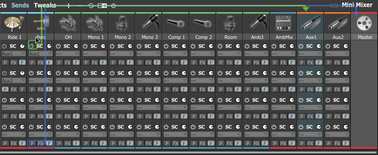
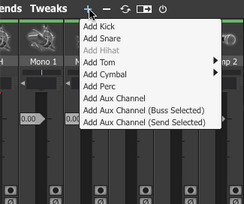
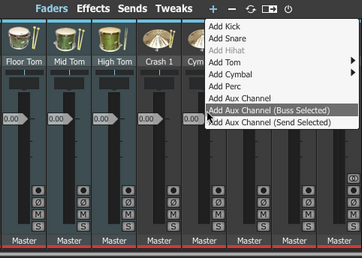
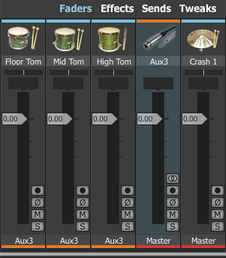
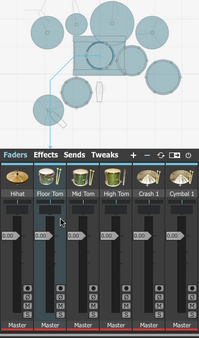
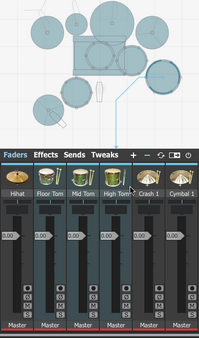
• CMD-click on a channel (Mac)

